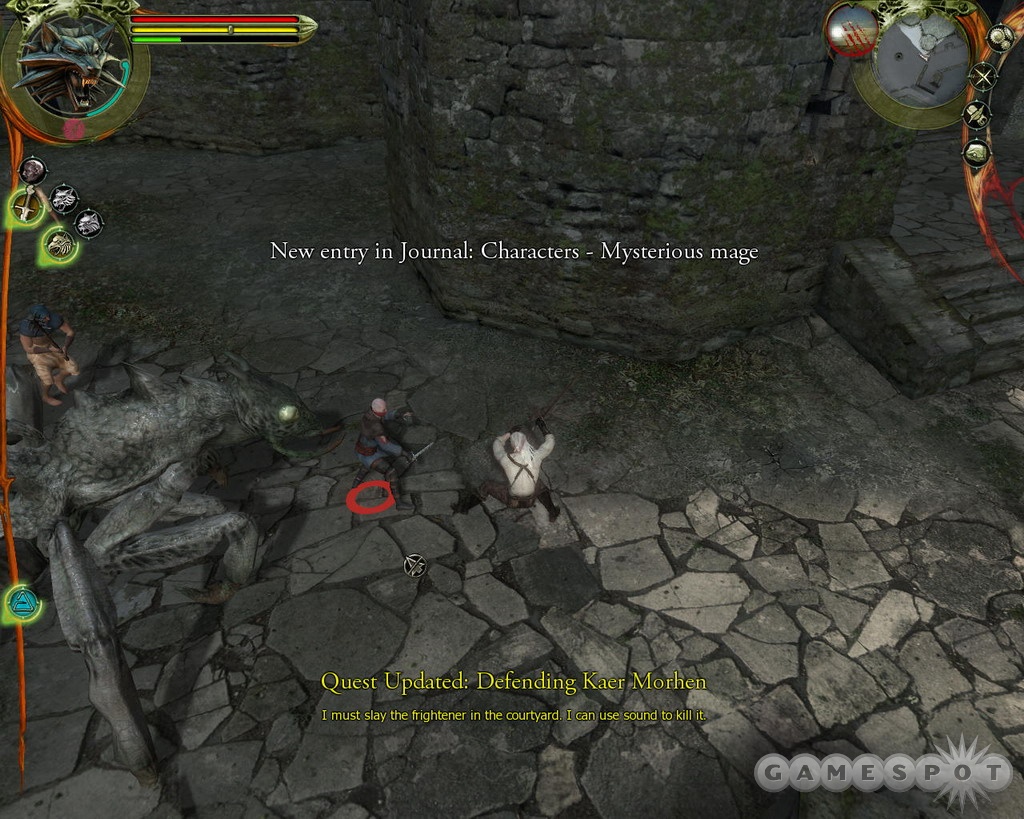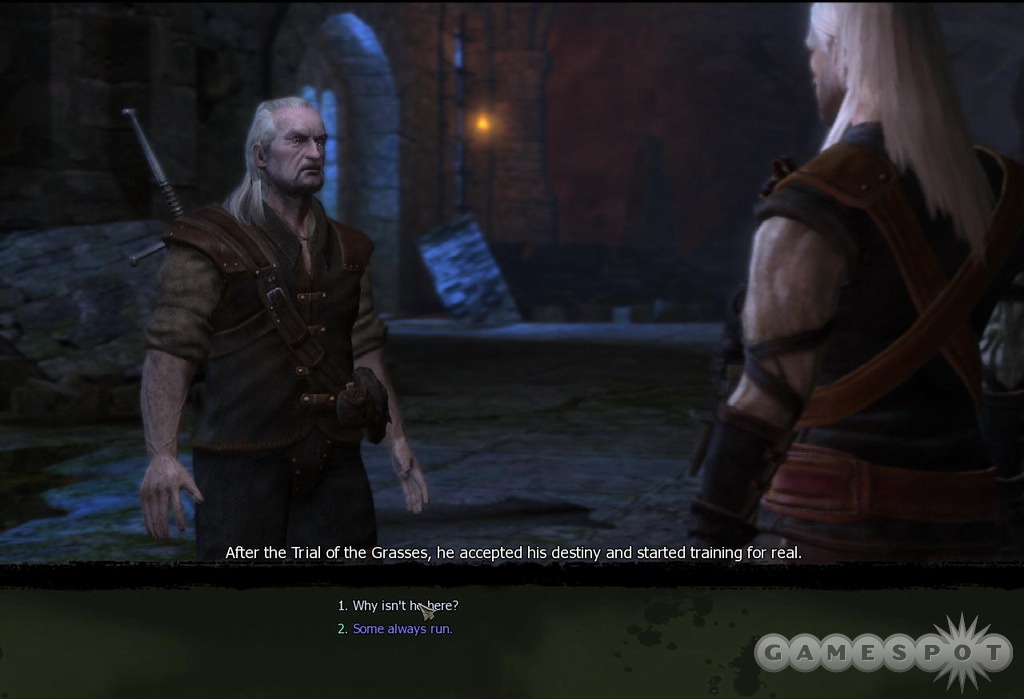The Witcher Hands-On - Combat and the Early Game
This fantasy role-playing game will deliver an intriguing antihero and a rich setting. It also has a deep and fast combat system.
The Witcher is a fantasy role-playing game that we've been looking forward to for a few years now. Based on the novels by Polish author Andrzej Sapkowski, The Witcher lets you play as his famous antihero, Geralt of Rivia. Geralt is a witcher, or a professional monster slayer in a medieval world that's full of intrigue and skullduggery. With The Witcher finally arriving near the end of the month, we got our hands on a near-final version of the game to check it out.

The game kicks off with a fairly lengthy cinematic that shows off Geralt's capabilities. Charged with saving a princess who is under a curse that turns her into a monster that comes out at night, Geralt uses the cursegiver as live bait to lure the princess out of hiding (the bait dies). He then uses a combination of swordplay, magic, and acrobatic ability to battle the monster. After battling, he reaches her sarcophagus before she does and seals himself inside of it. When dawn breaks, the curse is lifted and the lovely lass saved. That basically sums up Geralt: a ruthless killing machine that is also something of a ladies' man.
The story picks up some years after a massive war where Geralt apparently disappeared. (The Witcher picks up after the last and final Geralt novel, though you needn't have read it to understand what's going on. That's a good thing because the first book has only recently been translated to English.) Somehow he has returned sans his memory and rescued by the handful of remaining witchers left in the world. The witchers have holed up in Kaer Morhen, an abandoned castle in the middle of a vast forest. However, their time in the sanctuary is short-lived because a sorcerer accompanied by a giant preying-mantis creature called a frightener, as well as a small army of thugs and goons, attack the castle to steal the witchers' potent potions.
One of the interesting things about The Witcher is that there are two different ways to play the game. There's the traditional top-down isometric view that's similar to those found in other RPGs, such as Baldur's Gate and Neverwinter Nights. But there's also a close-to-the-ground camera that's more reminiscent of massively multiplayer online role-playing games, such as World of Warcraft. No matter what you select, you can easily switch to the other selection in the settings, so you can experiment.
The opening level is about defending the castle, which introduces you to The Witcher's combat system. The Witcher isn't like a lot of RPGs where combat is a fairly passive affair and you tell your character to attack an opponent then sit back, waiting for the battle to end. You have an active role during each and every swordfight in the game. When in combat, Geralt draws his sword and you can use double-clicks to make him leap forward or do acrobatic maneuvers, such as flips to the side. You click on opponents to initiate attacks, and then click again if the icon turns into a fiery sword, which indicates that you can chain combo attacks together to inflict even greater damage. However, you have to be quick because the moment of opportunity closes quickly. At the same time, you simply can't mash the mouse button frantically, because clicking too quickly can throw off Geralt's timing. Combat basically becomes a rhythm. If an enemy is stunned, then you can execute a perfect finishing move by clicking once more on the target. Finishing moves that we saw included Geralt leaping atop a foe and driving his sword into his chest, as well as cutting an enemy's legs out from under him then slitting his throat when he fell to his knees.
Sword styles are another facet of the combat that you have to take into account. There are three to choose from: strong, fast, and group. You can switch on the fly by tapping the Z, X, and C keys, respectively. You need to switch styles based on your opponent or opponents. Are you facing a nimble, lightly armored foe? Then select fast so you can use lightning fast swings to parry with him. However, are you battling a bigger or armored foe? The light swings of the fast style are unsuitable against such an opponent; you need the slower, heavier swings of the strong fighting style instead. But what if you're battling multiple foes? Then switch to the group mode, which lets you perform more broad attacks that hit multiple opponents in a single swing.

There's a third element to combat in The Witcher: potions. Witchers are something like alchemists, so they have a variety of potions that they can drink prior to a fight, which gives them special abilities. These potions have fairly elaborate names, such "tawny oil," which restores endurance more quickly. An important element in the game will be the ability to craft potions of your own. Finally, there are signs, which are basically witchers' magical abilities. The first that you learn is the "aard" sign, which is a telekinetic force that can knock opponents off of their feet or clear debris that's blocking your path. It plays a useful role in the battle against the giant frightener, as aard can knock the monster over, buying you time to deal with the many minions who are also swarming you.
When you put it all together, combat in The Witcher is pretty tactical for an RPG. There's a fair amount of depth there, as well as a fast pace that will keep you busy. There's also plenty of room to grow as you level up. When you reach a new experience level, you can distribute points across your character but figuring out what to specialize in is going to be tough. You can boost basic attributes, such as strength and intelligence. You can improve your abilities in either the fast, strong, or group combat styles, and because witchers have two swords (a silver one for monsters; a steel one for humans), there are two sets of combat styles that you can upgrade. You can also add talents, which are like little bonus skills or abilities, such as "buzz," which lets Geralt inflict 25 percent more damage when drunk; however, his ability to parry and dodge will take a 50 percent hit. So, yes, The Witcher does feature drunken fighting.
There's more to The Witcher than combat, though. We're impressed with the early part of the game. The story and characters are intriguing, particularly the way the game is loaded with branching points where you have to make a choice that can affect the plot significantly. The Witcher looks like it's going to provide a fresh new face to fantasy role playing when it's released later this year.
Got a news tip or want to contact us directly? Email news@gamespot.com
Join the conversation